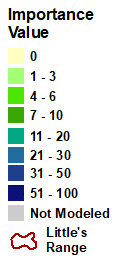red mulberry (Morus rubra)
Model Reliability: Low
| GCM SCENARIO | % Area Occ | Ave IV | Sum IV | Future/Current IV |
|---|---|---|---|---|
| Actual | 6.7 | 4.5 | 8909 | N/A |
| RFimp | 6.3 | 2.1 | 3797 | 0.43 |
| CCSM45 | 9.3 | 2 | 5451 | 1.44 |
| CCSM85 | 15.3 | 1.6 | 7061 | 1.86 |
| GFDL45 | 15.9 | 2 | 9436 | 2.48 |
| GFDL85 | 22.3 | 1.8 | 11627 | 3.06 |
| HAD45 | 14.5 | 1.8 | 7605 | 2 |
| HAD85 | 21.9 | 1.2 | 7968 | 2.1 |
| GCM45 | 18.7 | 1.4 | 7498 | 1.97 |
| GCM85 | 29.1 | 1 | 8887 | 2.34 |
Regional Summary Tree Tables
Summaries for tree species are available for a variety of geographies, in both PDF and Excel format. These summaries are based on Version 4 of the Climate Change Tree Atlas
Interpretation Guide
Red mulberry is fairly common (9.1% of area), but sparse and with low IV, across the eastern part of the region. The low reliable model suggests no change in habitat, but that there is good habitat in the western portion of the region. SHIFT classes it as a decent infill species for those areas. It is also moderately adaptable, yielding a fair capacity to cope with the changing climate.
Family: Moraceae
Guild: opportunistic, fast-growing understory tolerant
Functional Lifeform: small to medium-size deciduous tree
| 4.7 | 0.07 |
| 0.59 |  |
MODFACs
What traits will impact red mulberry's ability to adapt to climate change, and in what way?:
Primary Positive Traits
Shade tolerance Dispersal
Primary Negative Traits
Fire topkill



